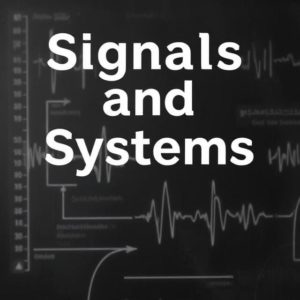Signals and Systems :
To understand signals and systems, let’s break down these two important concepts in a simple way.
- Signal: A way of transmitting information that changes over time (like sound, images, or data).
- Can be analog (smooth changes) or digital (step-like changes).
- System: A process or device that works with signals. It takes an input signal, modifies it, and produces an output signal.
- Systems can be linear (output is proportional to input) or nonlinear, and time-invariant

What is a Signal?
A signal is just a way of representing information that can vary over time. Think of a signal as a message that is carried by something that changes, such as a sound, light, or electrical current.
Example: When you speak, your voice creates sound waves, and these sound waves are a signal that carries information (your words) from your mouth to someone else’s ears. A signal can be:
Continuous: It changes smoothly without breaks, like sound waves in the air (this is called analog signal).
Discrete: It changes in steps or jumps, like numbers (0s and 1s) in a digital computer system (this is called a digital signal).
Types of Signals :
Analog Signal:
- An analog signal is a continuous signal that varies smoothly over time.
- It can take any value within a range.
- Example: The sound waves from your voice or the changing temperature in a room over time.
Digital Signal:
- A digital signal uses discrete values, often just 0s and 1s.
- It jumps between different values at certain points, rather than smoothly changing.
- Example: The data you send in a text message or the digital clock displaying the time in numbers.
What is a System?
A system is something that processes or modifies a signal in some way. A system takes an input signal (such as sound, light, or data), changes it, and produces an output signal.
Think of a system like a machine that works on a signal to produce a result.
- Example: If you speak into a microphone (input signal), the microphone might turn your voice into an electrical signal (the system processes the input) and send it to a speaker, which then produces sound again (output signal).
Types of Systems
Linear vs. Nonlinear Systems:
- Linear System: The output is directly related to the input. If you double the input signal, the output will double.
- Example: An amplifier that doubles the volume of a sound.
- Nonlinear System: The output is not directly proportional to the input. The relationship between the input and output is more complex.
- Example: A system that distorts sound in strange ways (like a guitar effect pedal).
Time-Invariant vs. Time-Varying Systems:
- Time-Invariant System: The system’s behavior doesn’t change over time. If you input the same signal at different times, you get the same output each time.
- Example: A simple echo system that always creates the same delay between the sound input and output.
- Time-Varying System: The system’s behavior changes over time. The same input signal can give a different output at different times.
- Example: A radio station where the signal changes with time due to different broadcasting conditions.
Signals and Systems in Real Life
- Sound Systems: When you talk, your voice (signal) is sent through a microphone (system), amplified, and played through speakers (output signal).
- Television: A TV signal is sent to your TV (input signal), and the TV system decodes it and displays the picture and sound (output signal).
- Cell Phones: Your voice is captured by the microphone (input signal), converted into a digital signal, sent over a network (system), and then converted back into sound on the other person’s phone (output signal).
Key Concepts in Signals and Systems
Signal Representation:
- A signal can be represented in many ways, such as:
- Waveform: A graph that shows how the signal changes over time.
- Frequency Domain: A way of analyzing the signal based on how often certain patterns repeat (instead of how the signal changes over time).
Processing Signals:
- Signals can be processed by systems in various ways:
- Amplification: Making a signal stronger (e.g., a louder sound).
- Filtering: Removing certain parts of the signal (e.g., removing noise from a voice recording).
- Modulation: Changing a signal to make it more suitable for transmission (e.g., radio signals).
Tags: analog signal, analog vs digital, audio signal, Communication Systems, continuous signal, digital signal, discrete signal, electrical signal, frequency analysis, frequency domain, input signal, light signal, linear system, nonlinear system, Output Signal, practical signal applications, real-time signal processing, Signal amplification, signal analysis, signal characteristics, signal examples, Signal filtering, Signal flow, signal modification, signal modulation, Signal Processing, signal representation, signal transformation, signal transmission, signal types, signal types in electronics, Signals and Systems, sound signal, system analysis, system behavior, system classification, system modeling, system output, system response, time domain signal, time-invariant system, time-varying system, voice signal processing., waveform


